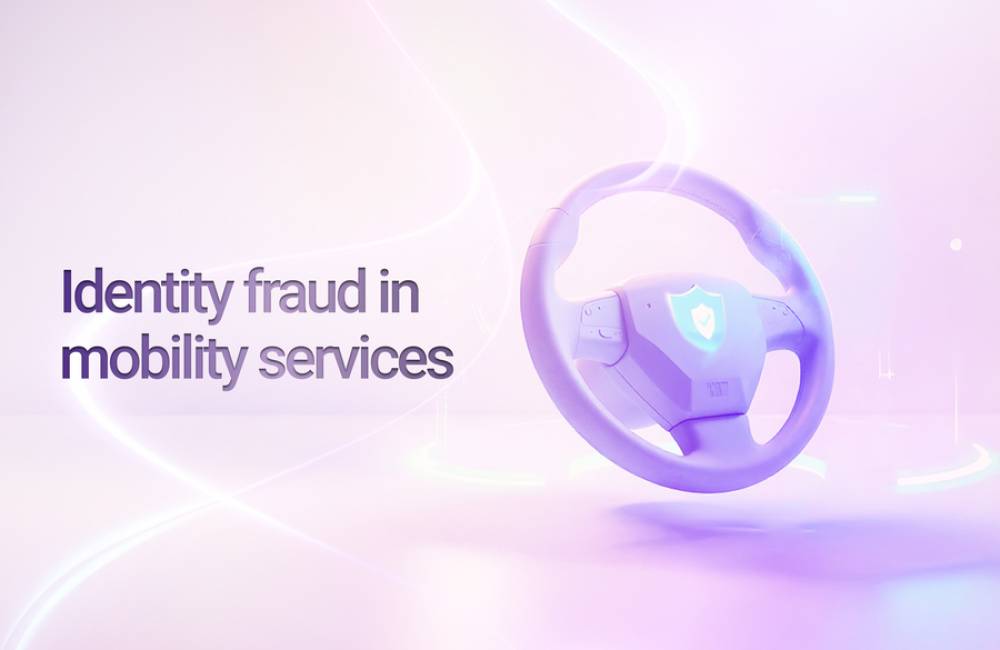Who's behind the wheel? Identity fraud in mobility services Written on

The shared mobility revolution promised convenience, sustainability, and seamless urban transportation. What it delivered instead was a perfect storm of opportunity for fraudsters. As the global mobility-as-a-service market exploded from $103.23 billion in 2022 to an estimated $328.98 billion in 2025, cybercriminals have been keeping pace.
This isn't just a technology problem or a customer inconvenience. Identity fraud in mobility services represents a fundamental threat to the industry's growth trajectory. As cities worldwide embrace mobility-as-a-service solutions and regulators tighten KYC compliance requirements, the stakes have never been higher.
Key takeaways
- Identity fraud is escalating: $16.6B in reported losses in 2024, with AI-generated schemes driving over half of all incidents.
- Mobility platforms are prime targets: Account takeovers enable fake trips, rating manipulation, and promotional abuse, eroding trust and revenue.
- Traditional verification is failing: Manual checks, static processes, and password-based logins can’t keep pace with sophisticated fraud tactics.
- Advanced identity verification is critical: AI-powered document analysis, biometric checks, and liveness detection ensure fast, accurate onboarding.
- Continuous authentication closes the gap: Ongoing, passive checks prevent account sharing and credential misuse without disrupting legitimate users.

The rising cost of identity fraud
Identity fraud has reached crisis levels. The FBI’s Internet Crime Report 2024 recorded 859,532 cybercrime complaints, with potential losses climbing to $16.6 billion. Credit card fraud remains the most common form of identity theft, representing nearly half of all reported cases. Attack sophistication has surged. AI-generated schemes now account for more than half of all fraud incidents, enabling criminals to operate at unprecedented scale and speed.
The financial fallout goes far beyond immediate monetary loss. Account takeovers create a ripple effect across mobility ecosystems: fraudsters can run fake trips using spoofed GPS data, manipulate ratings, and repeatedly exploit promotional campaigns. These actions erode the trust-based foundations mobility platforms rely on.
Reputational damage can be just as severe. Customers facing ride no-shows from fake driver profiles—and legitimate drivers wrongfully suspended due to stolen identities — lose faith in the platform. Once credibility is compromised on both sides of the marketplace, recovery becomes an uphill battle.
Why traditional verification methods are inadequate
Legacy identity verification approaches fail catastrophically in the fast-paced mobility environment. Traditional document checks, often manual or semi-automated, cannot keep pace with real-time onboarding demands while fraudsters leverage increasingly sophisticated deepfake technology and synthetic identity creation tools.
The mobile-first nature of mobility services compounds these challenges. Static, desktop-oriented verification processes create friction that legitimate users abandon, while providing numerous opportunities for fraudsters to exploit system vulnerabilities.
Basic username-password authentication proves woefully insufficient against modern fraud techniques. Credential stuffing attacks, where criminals use stolen login information across multiple platforms, succeed because many users recycle passwords across mobility services.
Identity verification: The future of mobility security
Advanced identity verification for mobility services operates through multi-layered, real-time analysis that goes far beyond traditional document checks. AI-powered systems analyze document authenticity using optical character recognition, micro-texture analysis, and advanced liveness detection to identify even sophisticated forgeries.
Biometric verification adds another critical layer, using facial recognition technology capable of detecting deepfakes and ensuring the person presenting identification matches the document photo. Modern systems can process this verification in under 60 seconds while maintaining accuracy rates above 99%.
However, even the most rigorous onboarding checks cannot prevent fraud if account sharing or credential theft occurs later. This is where continuous authentication becomes essential. Instead of verifying identity only once, these systems validate users throughout their active sessions.
By passively and periodically confirming that the person behind the wheel is the authorized account holder, continuous authentication makes account sharing unviable and drastically reduces the risk of fraudulent activity. The result is a stronger, ongoing security posture that protects both platform integrity and user’s trust — without adding friction to legitimate drivers’ experience.
Real-world applications
Mobility leaders are already putting these capabilities to work:
- Ride-hailing platforms using instant document checks and selfie matching to verify drivers within minutes without compromising safety.
- Car-sharing services combining document analysis and biometric checks to ensure vehicles are picked up in person.
- Mobility operators using mobile-friendly verification flows that blend document scanning with continuos authethication to detect account sharing while keeping the process quick.
- Fleet management providing enterprise-grade verification, including beneficial ownership checks and enhanced due diligence for high-value accounts.
The path forward: Building trust in motion
The choice facing mobility providers isn't whether to implement robust identity verification — it's how quickly they can deploy comprehensive fraud prevention while maintaining the user experience that drives adoption. Every day of delay represents more fraudulent accounts infiltrating systems, more legitimate users experiencing problems, and more opportunities for competitors with superior security to capture market share.
Protect drivers, riders, and revenue with our advanced identity verification and continuous authentication for mobility services.
(Sources: Tech Advisory, Mordor Intelligence, Experian)






